Clint Eastwood (Coogan's Bluff,
Kelly's Heroes) stars as the infamous "man
with no name", a gun for hire who arrives at the Mexican border town of San
Miguel looking to make a buck. He seizes an opportunity when he discovers that
the town is controlled by two different families, the Baxters and the Rojos,
and he's going to use the rivalry and suspicion that exists between the two to
play them for cash. Problems occur when he gets in a bit deep by rescuing a damsel
in distress, Ramon Rojo's (Volonte, Le Circle Rouge) abducted
mistress, Marisol (Koch, The Devil's General), setting off a chain of
events that threatens to lead to the destruction of both families.
A Fistful of Dollars is an unofficial remake of Akira Kurosawa's
Yojimbo, a lifting of the themes and style of that samurai film that
eventually ended with a settlement brought by a lawsuit from Kurosawa himself
(for what it's worth, Kurosawa bestowed praise on Leone's film).
Interesting to note is that the film that was once seen as borrowing from the
works of another would be even more influential in the world of film for what
new material its director and composer brought into it than what it would take
from others. Minimalist characterizations, sparse conversations,
highly-stylized shootouts, a surprising injection of comic relief, and a
sentimental, almost melancholy presentation that brings a certain feeling of
desolation and prolonged misery that is a byproduct of the amorality and
anarchy that represented this part of the old West -- it's all part and parcel
of Leone's vision that would set the tone for antiheroes to dominate the genre
from here on out.
Eastwood, who had some success prior to this film in bit roles and on
television in the popular Western series, "Rawhide", catapulted to stardom
after the international release of the "Dollars" trilogy, and for good reason.
Perhaps not since John Wayne himself had an actor so prominently evoked a
feeling of screen presence, a man who says little, does much, and always seems
to have the upper hand, even when the chips are down. His intelligence,
charisma, and squinty-eyed looks made him a man worth watching, and someone
you want to believe in. Though not the first choice for the part, it's
hard to imagine any of the other considered actors (Henry Fonda, Charles
Bronson, James Coburn -- three actors that Leone would use in later films) to
be as commanding in the prolonged quiet and carry the same aura of calculated,
measured dominance.
Eastwood perfectly embodies this character that has you believe that
one man could take on a community of the baddest of the bad, and still come
out ahead because he is willing to cross just as many lines, and his lack of
family, history and earthly possessions means he has nothing to lose -- with
no discernable vulnerability, no one can touch him. The lack of
vulnerability comes into full play in one of the most famous scenes in any
Western, as Eastwood get shot multiple times and rises from the ground just as
many times to haunt the lying eyes of the film's main villain, Ramon.
The mystique turns to legend, but he reveals himself to be just a man -- a man
who proves that the edge in a fight is not firepower or brawn, but ingenuity,
knowing how to play the right angles at the right times to divide and conquer
all opposition.
For all of its prominence as the first significant Spaghetti Western to emerge
from the mid-1960s, A Fistful of Dollars would not be the best to come
out, as its sequel, For a Few Dollars More,
would show that Leone could deliver even more mightily without the need for
lifting of themes from others, fully capturing the essence of the character of
the Man with No Name as the ultimate in morally ambiguous antiheroes.
The final film in the arc, The Good the Bad and the Ugly would become
legendary, and practically diminish all others, leaving A Fistful of
Dollars feeling like a first draft to ideas, concepts and
characterizations that culminated in what would end up being one of the
masterpieces of the Western genre. Still, for a film that has everyone
feeling around for the right fit, it's one hell of a memorable debut for all
involved.

